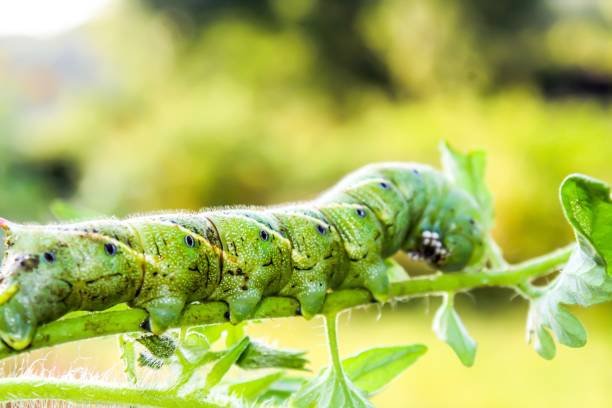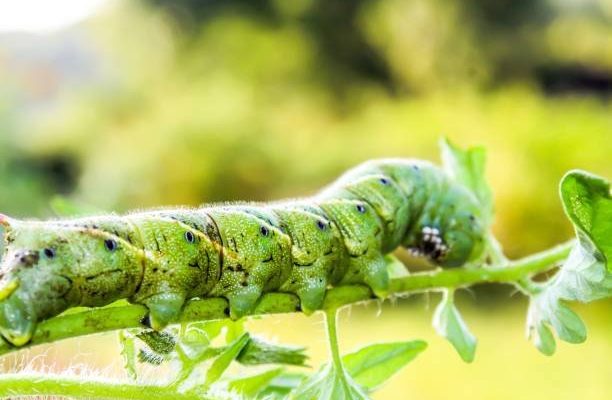
Diatomaceous earth is like the superhero of the gardening world. This natural powder is made from the fossilized remains of tiny aquatic organisms called diatoms. It’s a great way to control hornworms without using harmful chemicals. Using diatomaceous earth for hornworm control allows you to protect your plants while keeping your garden safe and healthy.
Let’s dig deeper into how diatomaceous earth works, how to use it effectively, and tips to keep your garden thriving while managing these green pests.
What are Hornworms?
To understand how to control hornworms, we first need to know what they are. Hornworms are the larvae of hawk moths, and they can grow up to 4 inches long! They’re often green, which helps them blend in with the leaves of plants. This camouflage makes them tricky to spot until they’ve already done some damage.
You might be wondering, “How do I know if I have hornworms in my garden?” One telltale sign is the presence of large holes in your plants’ leaves. Additionally, you might find frass—small droppings—on the ground beneath affected plants. If you see this, it’s time to take action!
Why Use Diatomaceous Earth?
Here’s the thing: many commercial pesticides can be harsh on beneficial insects and the environment. Diatomaceous earth offers a safer alternative. When applied to your garden, it does not harm plants or insects like bees and ladybugs. Instead, it targets pests like hornworms by disrupting their exoskeletons. This disruption leads to dehydration and ultimately death.
Diatomaceous earth is also versatile. It can be used in various settings—whether you’re dealing with hornworms in a vegetable patch or even in flower gardens. Plus, it’s an organic product, which means you can feel good about using it around your family and pets.
How to Apply Diatomaceous Earth
Applying diatomaceous earth is straightforward, but there are some best practices to keep in mind. Here’s how to do it effectively:
1. **Choose the Right Type**: Make sure to use food-grade diatomaceous earth, as it’s safe for gardens and won’t pose a risk to humans or pets.
2. **Prepare Your Area**: Before application, check for any existing pests. If you can, remove any visible hornworms or damage.
3. **Apply the Powder**: Use a dust spreader or simply sprinkle the powder around the base of your plants and on the leaves. Aim for a thin, even layer.
4. **Timing Matters**: Apply diatomaceous earth early in the morning or late in the evening. The heat from the sun can make it less effective, as it needs to stay dry to work properly.
By following these steps, you’ll create a barrier that hornworms won’t want to cross.
When to Reapply Diatomaceous Earth
Here’s something to keep in mind: diatomaceous earth doesn’t remain effective indefinitely. You’ll want to reapply it after rain or watering, as moisture can wash it away. Monitoring your plants regularly will help you maintain a solid defense.
Additionally, if you notice that hornworms are still popping up, you might need to adjust your application method. Consider using a thicker layer or targeting specific areas where you see more hornworm activity.
Complementing Diatomaceous Earth with Other Methods
While diatomaceous earth is a fantastic tool for hornworm control, it’s even better when used alongside other methods. Here are a few complementary strategies worth considering:
– **Handpicking**: This old-school method can be surprisingly effective. If you spot a hornworm, simply remove it by hand and dispose of it.
– **Beneficial Insects**: Introduce beneficial predators like parasitic wasps or birds into your garden. These allies will help keep hornworm populations in check naturally.
– **Companion Planting**: Certain plants can repel hornworms. Consider planting herbs like basil, which may deter pests while attracting beneficial insects.
By diversifying your approach, you’ll strengthen your defenses against these pesky caterpillars.
Common Mistakes When Using Diatomaceous Earth
Even with a great product like diatomaceous earth, there are some common pitfalls to watch out for. Here are a few mistakes to avoid:
– **Not Using Enough**: A light dusting might not be enough. Ensure you cover the necessary areas adequately.
– **Applying When Wet**: Remember, diatomaceous earth needs to be dry to be effective. Applying it during or right after rainfall won’t help your cause.
– **Ignoring Reapplication**: It’s easy to forget about reapplying after it rains or after watering your plants. Set a reminder to check your application regularly.
By steering clear of these mistakes, you’ll maximize the effectiveness of your pest control efforts.
Controlling hornworms doesn’t have to feel overwhelming. With diatomaceous earth in your gardening toolkit, you have a natural and effective way to protect your plants. Remember to apply it correctly, keep up with reapplications, and combine it with other strategies like handpicking and inviting beneficial insects. With a little diligence and the right approach, your garden can thrive without falling victim to these green munchers. So, grab that diatomaceous earth, and let’s get to work on keeping your garden healthy and happy!

